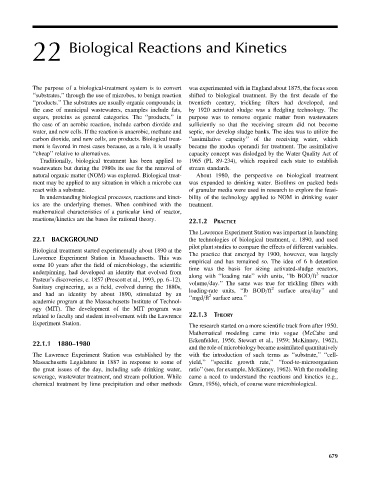Page 724 - Fundamentals of Water Treatment Unit Processes : Physical, Chemical, and Biological
P. 724
22 Biological Reactions and Kinetics
The purpose of a biological-treatment system is to convert was experimented with in England about 1875, the focus soon
‘‘substrates,’’ through the use of microbes, to benign reaction shifted to biological treatment. By the first decade of the
‘‘products.’’ The substrates are usually organic compounds; in twentieth century, trickling filters had developed, and
the case of municipal wastewaters, examples include fats, by 1920 activated sludge was a fledgling technology. The
sugars, proteins as general categories. The ‘‘products,’’ in purpose was to remove organic matter from wastewaters
the case of an aerobic reaction, include carbon dioxide and sufficiently so that the receiving stream did not become
water, and new cells. If the reaction is anaerobic, methane and septic, nor develop sludge banks. The idea was to utilize the
carbon dioxide, and new cells, are products. Biological treat- ‘‘assimilative capacity’’ of the receiving water, which
ment is favored in most cases because, as a rule, it is usually became the modus operandi for treatment. The assimilative
‘‘cheap’’ relative to alternatives. capacity concept was dislodged by the Water Quality Act of
Traditionally, biological treatment has been applied to 1965 (PL 89-234), which required each state to establish
wastewaters but during the 1980s its use for the removal of stream standards.
natural organic matter (NOM) was explored. Biological treat- About 1980, the perspective on biological treatment
ment may be applied to any situation in which a microbe can was expanded to drinking water. Biofilms on packed beds
react with a substrate. of granular media were used in research to explore the feasi-
In understanding biological processes, reactions and kinet- bility of the technology applied to NOM in drinking water
ics are the underlying themes. When combined with the treatment.
mathematical characteristics of a particular kind of reactor,
reactions=kinetics are the bases for rational theory.
22.1.2 PRACTICE
The Lawrence Experiment Station was important in launching
22.1 BACKGROUND the technologies of biological treatment, c. 1890, and used
pilot plant studies to compare the effects of different variables.
Biological treatment started experimentally about 1890 at the
The practice that emerged by 1900, however, was largely
Lawrence Experiment Station in Massachusetts. This was
empirical and has remained so. The idea of 6 h detention
some 10 years after the field of microbiology, the scientific
time was the basis for sizing activated-sludge reactors,
underpinning, had developed an identity that evolved from 3
along with ‘‘loading rate’’ with units, ‘‘lb BOD=ft reactor
Pasteur’s discoveries, c. 1857 (Prescott et al., 1993, pp. 6–12).
volume=day.’’ The same was true for trickling filters with
Sanitary engineering, as a field, evolved during the 1880s, 2
loading-rate units, ‘‘lb BOD=ft surface area=day’’ and
and had an identity by about 1890, stimulated by an 2
‘‘mgd=ft surface area.’’
academic program at the Massachusetts Institute of Technol-
ogy (MIT). The development of the MIT program was
related to faculty and student involvement with the Lawrence 22.1.3 THEORY
Experiment Station.
The research started on a more scientific track from after 1950.
Mathematical modeling came into vogue (McCabe and
Eckenfelder, 1956; Stewart et al., 1959; McKinney, 1962),
22.1.1 1880–1980
and the role of microbiology became assimilated quantitatively
The Lawrence Experiment Station was established by the with the introduction of such terms as ‘‘substrate,’’ ‘‘cell-
Massachusetts Legislature in 1887 in response to some of yield,’’ ‘‘specific growth rate,’’ ‘‘food-to-microorganism
the great issues of the day, including safe drinking water, ratio’’ (see, for example, McKinney, 1962). With the modeling
sewerage, wastewater treatment, and stream pollution. While came a need to understand the reactions and kinetics (e.g.,
chemical treatment by lime precipitation and other methods Gram, 1956), which, of course were microbiological.
679

